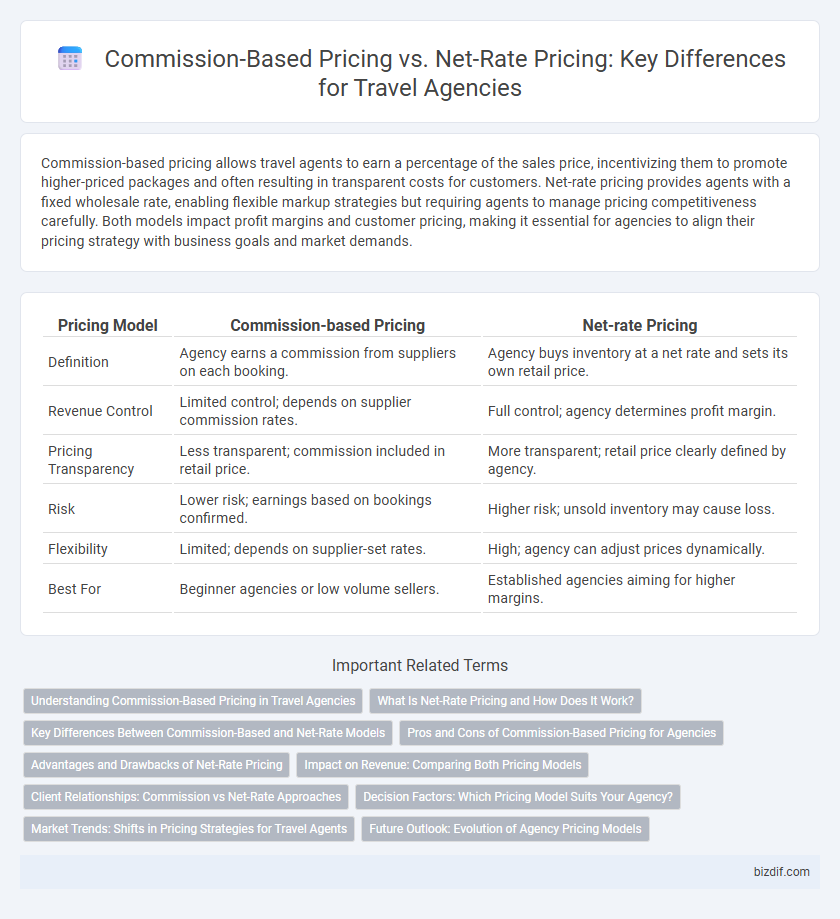Commission-based pricing allows travel agents to earn a percentage of the sales price, incentivizing them to promote higher-priced packages and often resulting in transparent costs for customers. Net-rate pricing provides agents with a fixed wholesale rate, enabling flexible markup strategies but requiring agents to manage pricing competitiveness carefully. Both models impact profit margins and customer pricing, making it essential for agencies to align their pricing strategy with business goals and market demands.
Table of Comparison
| Pricing Model | Commission-based Pricing | Net-rate Pricing |
|---|---|---|
| Definition | Agency earns a commission from suppliers on each booking. | Agency buys inventory at a net rate and sets its own retail price. |
| Revenue Control | Limited control; depends on supplier commission rates. | Full control; agency determines profit margin. |
| Pricing Transparency | Less transparent; commission included in retail price. | More transparent; retail price clearly defined by agency. |
| Risk | Lower risk; earnings based on bookings confirmed. | Higher risk; unsold inventory may cause loss. |
| Flexibility | Limited; depends on supplier-set rates. | High; agency can adjust prices dynamically. |
| Best For | Beginner agencies or low volume sellers. | Established agencies aiming for higher margins. |
Understanding Commission-Based Pricing in Travel Agencies
Commission-based pricing in travel agencies involves earning a percentage of the total booking value as a fee from suppliers such as airlines, hotels, or tour operators. This model incentivizes agencies to promote specific products that offer higher commissions but may limit price transparency for customers. Understanding commission-based pricing helps travelers assess the true cost of services and compare offers more effectively.
What Is Net-Rate Pricing and How Does It Work?
Net-rate pricing is a travel agency model where the agent purchases services such as hotels or tours at a predetermined wholesale rate, then sets their own retail price to customers. This approach allows agencies to control their profit margins by marking up the net rate according to market demand and competition. Agencies benefit from transparency and flexibility, attracting price-sensitive travelers while maintaining profitability.
Key Differences Between Commission-Based and Net-Rate Models
Commission-based pricing allows travel agencies to earn a percentage of the total booking value, incentivizing higher sales volumes and customer service quality. Net-rate pricing involves agencies purchasing travel services at a fixed wholesale price and setting their own retail prices, maximizing control over profit margins and pricing strategies. Key differences include revenue predictability, pricing flexibility, and the level of risk borne by the agency in managing inventory and sales.
Pros and Cons of Commission-Based Pricing for Agencies
Commission-based pricing allows travel agencies to earn a percentage of the total sale, incentivizing them to boost bookings and build client relationships. However, this model can create conflicts of interest, as agencies might prioritize higher commissions over customer needs, potentially compromising service quality. Reliance on commission can also lead to revenue fluctuations, making financial planning and cash flow management more challenging for agencies.
Advantages and Drawbacks of Net-Rate Pricing
Net-rate pricing offers travel agencies greater control over profit margins by allowing them to set their own retail prices while purchasing at a fixed rate from suppliers. This model enhances flexibility and potential profitability but requires agencies to invest in strong marketing to attract customers since prices are not pre-marketed as fixed commissions. A key drawback is the upfront financial risk as agencies must pay suppliers regardless of sales, which can impact cash flow and inventory management.
Impact on Revenue: Comparing Both Pricing Models
Commission-based pricing allows travel agencies to earn a percentage of the total booking value, directly linking revenue to sales volume and incentivizing higher customer bookings. Net-rate pricing involves agencies purchasing travel products at a fixed wholesale rate and adding a markup, providing greater control over profit margins but requiring effective pricing strategies to maintain competitiveness. Both models impact overall revenue differently; commission-based pricing offers variable income aligned with sales, while net-rate pricing offers predictable margins but demands strong market knowledge to maximize profitability.
Client Relationships: Commission vs Net-Rate Approaches
Commission-based pricing fosters transparent client relationships by allowing travel agencies to earn a percentage of the total trip cost, which can encourage agencies to recommend higher-value options without directly increasing the client's upfront expenses. Net-rate pricing offers clients access to discounted rates not visible to the public, promoting trust through exclusive deals, though it requires clear communication to avoid perceptions of hidden markups. Both approaches impact client loyalty and satisfaction differently, making the choice crucial for agencies aiming to balance profitability with long-term relationship building.
Decision Factors: Which Pricing Model Suits Your Agency?
Commission-based pricing provides travel agencies with a percentage of the total booking value, aligning revenue with sales volume and incentivizing high booking throughput. Net-rate pricing offers fixed costs, allowing agencies greater control over markup strategies and profit margins, often preferred by those targeting niche markets or customized packages. Agencies should consider their client base, cash flow preferences, and market positioning when choosing between these models to maximize profitability and operational efficiency.
Market Trends: Shifts in Pricing Strategies for Travel Agents
Travel agencies increasingly adopt commission-based pricing, leveraging supplier partnerships to maximize profit margins amid competitive markets. Net-rate pricing gains traction as agents seek transparent pricing models, offering fixed rates from wholesalers to enhance client trust. Market trends reveal a hybrid approach emerging, combining commission incentives with net rates to optimize revenue streams and client satisfaction.
Future Outlook: Evolution of Agency Pricing Models
Commission-based pricing has historically dominated travel agency revenue streams, but emerging trends show a gradual shift towards net-rate pricing models driven by increased transparency and direct supplier relationships. Net-rate pricing enables agencies to offer more competitive, customized packages by purchasing wholesale rates and adding service fees, fostering flexibility in dynamic market conditions. The future of agency pricing models will likely blend these approaches, leveraging technology and data analytics to optimize profitability and customer value in a highly competitive travel industry.
Commission-based pricing vs Net-rate pricing Infographic

 bizdif.com
bizdif.com